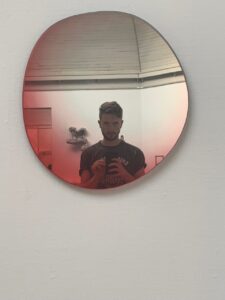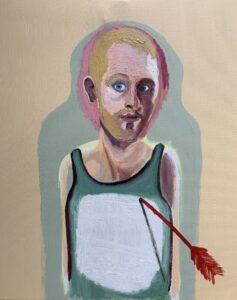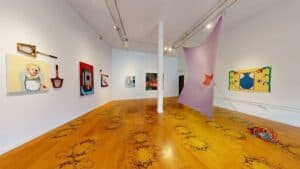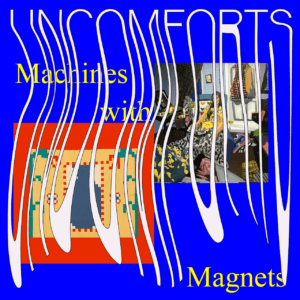Bantam Check-in with Maxwell Fertik ’19
Max Fertik ’19 is an artist and Trinity graduate who has found new ways to collaborate during the pandemic.

What has your experience been like over the past few months? How has the pandemic impacted your work?
In many ways, this time has stretched my brain in a way that allowed me to trust my instincts and experiment wildly, free of judgement. What started as bewilderment actually pushed me back into work both in activism and in artmaking. My artwork is usually concerned with interaction, shelter, and the manipulation of social space but most of this period has been spent sketching and conceptualizing. These months have made me look deeply into my practice and how I can deepen my relationship with the world outside of my phone and be open to a wide range of possibilities. I took the time to step away from extravagant installations and into smaller works and projects that engage my local community.

When this began, I had recently returned from working for some time for the artist and designer, FOS in his studio in Copenhagen and was already grappling with how this would affect my work. He made me understand how important hands-on proficiency is to making quality work and what it can inform about my psychology. He also made me think of every interior space as a stage for “everyday performance.”
When I returned, I applied to a master’s degree program at RISD hoping to spend my next few years analyzing where my voice would have the most weight in this field. These months of pandemic and social/racial upheaval have also made me more thoughtful about what I produce and made me acutely aware of so many questions that have come to the surface: Who is the work serving? What is my true objective in the work? What voices am I displacing by showing work? How can I boost these voices and retain a strong sense of transparency? My work has shifted more into curation in these past months and preparing dramatic physical concepts for next year. It was a time for instinctual making without judgement and reflecting on what stories I really want to tell. But my main creative output was un/comforts.

How have you found inspiration during this time to keep making art?
What has inspired me is this feeling of “shared aloneness” that I keep hearing more and more about. It is this feeling that we are becoming more and more involved in each other’s lives despite experiencing everything in isolation. I think this phenomenon is nothing new but something made more apparent in the recent months. Everyone is struggling to make the best of this feeling and survive by whatever means necessary, but this is a personal struggle that such a massive group is experiencing simultaneously. I think the way that many artists are not concealing this personal struggle but rather bearing it and exposing this private fear that many of us face has been hugely inspirational to me. So many unknown artists are hustling their work like never before, more collaborations are happening, and greater risks are being taken. It certainly feels like death and time are more present in our lives than they might normally be and this has empowered us to create without excuses. This is the main reason I chose to do a self-portrait for un/comforts. It was a necessary step for me to destroy this version of myself from before and restore to something less driven by ego and more driven by this relation to a whole.
How did you make this virtual art show happen, and what do you think you learned from showcasing art virtually as opposed to in person?

un/comforts has been in the works roughly since January. It was a product mainly of me reconnecting with a friend of mine, Chase Buckley, who I have known since kindergarten, but we had lost touch in recent years. We quickly realized that we worked well together and both brought a different outlook to the table. Several meetings later, we decided to join forces with Machines with Magnets, a reputable art gallery/music studio in Pawtucket, RI and build an art show outward from the idea of “privacy and intimacy in domestic space.” We handpicked nine artists, a handful from my community at RISD and Trinity, and a handful from Chase’s community at MassArt. Each brought something distinct and visceral, all were instructed to engage with their private performance that happens when no one is watching, when they feel the most themselves inside the home. Regrettably, our in-person show was called off and our May opening date was pushed to “indefinite.” We were disappointed, discouraged and struggling with how to move forward.
On a whim, after almost a month of inaction, I decided to reach out to Artland. They are the largest art publication in Scandinavia and I only knew of them because they interviewed FOS when I worked for him and were known for their stunning 3D-scanned exhibitions. I did not expect them to answer me. But, just about two days after writing them, explaining our circumstances, we got a response. Not only did they want to partner with us, but they offered to find someone in our area to come and 3D scan the gallery for online VR viewing. We were speechless and we got right to work. From that point on, it was a full-time push until the installation, which took about a week to fully manifest. But finally, on July 25th, we had a show in a gallery with no one allowed to view it in person.
Nonetheless, we are proud of un/comforts and feel strongly that the VR platform is the next best thing to viewing it in person. Each piece beautifully reflects this sense of “shared aloneness” that I mentioned earlier. It points to this distressing and sustaining feeling of being isolated within familiar space but equally offers a vision of adaptable futures unhindered by trauma. While I recommend viewing and reading each individual piece with their statements, I will say that some pieces approach the theme with playful, nostalgic sentiment while some play more with peaceful, neutral self-awareness, (namely Alison Cofrancesco ’20), and others share a visceral self-reckoning that confronts the viewer head-on. Ultimately, the virtual platform offered so much more than we ever imagined and allowed us to reach a wider audience than we would have before. It will also be up forever on the platform. In a recent interview we did, someone brought up the fact that “un/comforts is a show about being alone in bed that you can view while alone in bed.”
We were among the first 25 American shows published on the Artland platform, the first Rhode Island show on the platform, and the first by two curators under the age of 25.
What has living in the world since COVID-19 taught you about isolation and creativity?
What I’ve learned is that I need some kind of structure to do anything, even if that structure is one I have to make for myself. I have found that when that structure is suddenly removed, I have trouble finding center and end up somewhere between Google Earth and a deep Wikipedia rabbit hole. It’s funny to see how technology is playing such a massive role in this and we’re learning how much can actually be done from home. But at the same time, it’s tough to justify making art when the world seems to be tearing at the seams. How do we continue this performance of domestic life when everyday we’re hit with some new, absurd injustice of the present? If there is anything I have learned from this period of isolation, it’s that we cannot keep ignoring the central role we play in both our health and that of our planet. I am optimistic we can make change but it starts at the individual level.
How are you continuing to connect with Trinity alumni and the Trinity community?
In February, Trinity asked to acquire one of my paintings for their permanent collection thanks to Christina Bleyer, director of special collections and archives at the Watkinson. I was also sure to include another Trinity artist, Alison Cofrancesco ’20 in un/comforts because I think studio arts is an underrepresented major at Trinity and much of the work that happens in that small group goes unnoticed. I hope to be the one to change that. While I am excited to be attending RISD in January, I found my confidence at Trinity and will always look to Professors Joe Byrne and Pablo Delano for guidance. I was lucky enough to be in a small but strong studio arts cohort at Trinity and without it, I would not have leaned so deeply into my practice nor would I have gone to work with FOS in Denmark.
I received a great education from Trinity but I am constantly reminded of how much we can improve as an institution. We need more voices of allyship, more solidarity with LGBTQ+ and BI/POC communities, and a more actively antiracist community of alumni. This is something we can always work on no matter who we are after Trinity.
View Fertik’s work and the un/comforts virtual show here.
Want to share your story in a Bantam Check-In? Get in touch.
